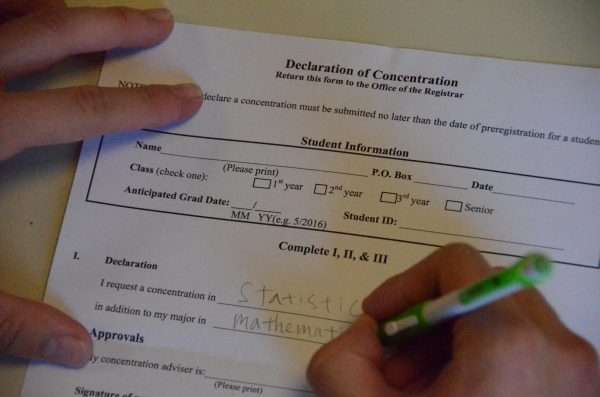Your priority registration questions answered
October 31, 2022
The fall season at Grinnell College is typically a time of change: the leaves fall, the weather tries to sort itself out and, this year specifically, the College is rolling out a new iteration of the pre-registration system. Though the new method seeks to address equity and consistency, some students have questions about how the new system impacts the process for major requirements. The S&B has addressed some of these concerns with the registrar.
After WebAdvisor, the previous registration system, was retired by its software company, the College used an updated process as part of the Colleague Self-Service. This approach was based on discussion and review by the curriculum committee, faculty, administration and students over the course of the previous academic year.
The curriculum committee, which is comprised of four professors from different departmental divisions, worked to ensure that faculty had opportunities to review and provide feedback for changes while student educational policy committee groups provided feedback and divisional representation in curriculum committee meetings. Catherine Ashton, registrar of the College, asserted that the system was created to improve the registration experience for students.
“The goals for adjusting the registration system are more transparency for students, improved schedules and offerings based on student priority selections and an equitable process that ensures every student has the opportunities they are seeking at Grinnell,” said Ashton.
The new system breaks pre-registration into four rounds. All students initially sign-up for up to nine credits in round one. In round two, students that were cut from their first-choice classes are given the chance to reassign their priority classes. Rounds three and four allow students to place themselves on waitlists and make final changes to their schedules. Unlike previous years, these waitlists are managed institutionally instead of by individual professors.
“Using institutional waitlists ensures equity for all students. The system records data and information that can be used to help inform registration practices and schedules in the future,” said Ashton.
The new approach to waitlists also attempts to factor in student concerns regarding progress in their major and their immediate graduation requirements.
“Those priorities will also be built into the waitlist system to help address student concerns about meeting graduation requirements,” Ashton said. “Rounds two, three and four also allow students to make informed decisions about registration in a section based on the seats available.”
Within specific majors with rigid requirements, like computer science, there have been concerns within the department that the new system forces students to prioritize classes required for their major in order to meet their graduation requirements.
“If too many people sign up for two courses, it’s likely that they’ll get stabbed in the foot and not have any courses to take, which is lame because sometimes two interesting courses are only offered during certain semesters,” said Jasper Gray `24, a computer science major.
Certain majors also have comparatively linear requirements for 200- and 300-level courses, which can incentivize departments to restrict access to certain courses for non-majors who have made progress in the major.
Gray said that in the computer science department in particular, “many people only have two options of courses to take and that causes issues because they’ll have to sign up for those courses and will be more likely to get cut from them. Not to mention, if people who aren’t computer science majors would like to take them just for fun, that’s basically impossible.”
While waitlists are prioritized by class years, they also operate on a first-come, first-serve basis. Students are no longer able to appeal to professors based on personal circumstances. In the case of specific double majors, this oversight can leave specific demographics of students worried about their ability to complete their degree confidently.
“If someone is doubling in chem and CS, the required courses often conflict with labs. Because it is so systematic, there’s not much wiggle room,” Gray said.
In terms of support and assistance, the registrar offers itself, advisors and department chairs as resources to address conflicts throughout the process.
“Put your name on the waitlist, notify your advisor and then check your email,” Ashton said. “The registrar’s office will be working with advisors and department chairs to ensure students are making appropriate progress through declared programs.”
“This should help all students to make more consistent and conscientious registration decisions throughout their academic experience,” said Ashton.








































































